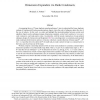Free Online Productivity Tools
i2Speak
i2Symbol
i2OCR
iTex2Img
iWeb2Print
iWeb2Shot
i2Type
iPdf2Split
iPdf2Merge
i2Bopomofo
i2Arabic
i2Style
i2Image
i2PDF
iLatex2Rtf
Sci2ools
331
click to vote
APPROX
2015
Springer
2015
Springer
Dimension Expanders via Rank Condensers
An emerging theory of ŌĆ£linear-algebraic pseudorandomnessŌĆØ aims to understand the linear-algebraic analogs of fundamental Boolean pseudorandom objects where the rank of subspaces plays the role of the size of subsets. In this work, we study and highlight the interrelationships between several such algebraic objects such as subspace designs, dimension expanders, seeded rank condensers, two-source rank condensers, and rank-metric codes. In particular, with the recent construction of near-optimal subspace designs by Guruswami and Kopparty [GK13] as a starting point, we construct good (seeded) rank condensers (both lossless and lossy versions), which are a small collection of linear maps Fn ŌåÆ Ft for t n such that for every subset of Fn of small rank, its rank is preserved (up to a constant factor in the lossy case) by at least one of the maps. We then compose a tensoring operation with our lossy rank condenser to construct constant-degree dimension expanders over polynomially large ’...
| Added | 16 Apr 2016 |
| Updated | 16 Apr 2016 |
| Type | Journal |
| Year | 2015 |
| Where | APPROX |
| Authors | Michael A. Forbes, Venkatesan Guruswami |
Comments (0)

